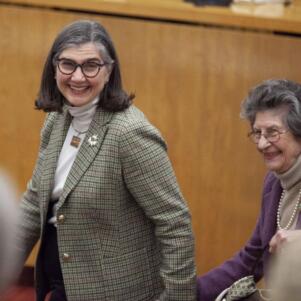Resolving to ‘cure cancer,’ Obama promises the impossible
By Nial Wheate | January 19, 2016, 9:11 EST
 (AP Photo/Jacquelyn Martin)
(AP Photo/Jacquelyn Martin) In his 2016 State of the Union address last week, United States President Barack Obama declared he wanted America to be the country that “cures cancer once and for all.”
Obama’s goal is unrealistic, too simplistic and not achievable by the United States, or any other country. Cancer is not just one but a group of more than 100 different diseases, for which no single cure will ever be effective.
Finding better drugs to treat cancer effectively and with fewer side effects will certainly help reduce the number of people who die from the disease. But instead of romantic hopes for cancer “cures,” countries need to invest more to find better methods for early detection and awareness campaigns to promote healthier lifestyles.
What do we mean by cure?
Firstly, something this important can’t be solved by one country. Cancer knows no national boundaries as it affects families across the world. We need a globally coordinated program to find better treatments so research and costs are not duplicated.
Next, the phrase “a cure for cancer” is empty because few people, if any, know what it actually means. It could mean total eradication of the disease. That is, preventing it from developing in the first place, like the way the world eradicated smallpox.
It might also mean finding a single drug that, when given to any cancer patient, will effectively cure them of the disease without need for surgery or radiotherapy.
Both definitions are unrealistic. And when it comes to cancer, there is no such thing as a “cured” patient, in the way that a patient can be cured of other diseases, such as infections. After treatment, there can be some leftover cancer cells, which may redevelop into cancer.
Sadly, a patient may also develop entirely new cancers or, worse, get a new cancer that is actually caused by the chemotherapy treatment they received for the initial disease.
Doctors don’t use words like “cure.” Instead they talk in terms of five-year survival rates. That is, the percentage of patients who live for five years post-cancer diagnosis for a given treatment.
We’ve seen some real progress in this area in the last few decades. Compared to around 30 percent in the 1970s, today around 70 percent of people will live for five years after diagnosis. So what we’re looking for, when we say we’re looking for a cure, is really getting that long-term survival rate as close to 100 percent as possible.
Why we can’t cure cancer
Our understanding of cancer has improved remarkably from a hundred years ago when we thought it was caused by trauma and was infectious.
Now we have some certainties in our cancer knowledge. We know that the human papillomavirus causes causes most cervical cancers and that smoking causes most lung cancer. We know that being overweight and having a poor diet increase the risk of bowel and bladder cancer.
Most importantly, we’ve discovered that many types of cancers we thought were identical are actually completely different. Typically, doctors classify cancers based on the region of the body in which they are found. Patients are routinely told they have breast cancer or lung cancer, for instance.
But now we know this is a poor method of diagnosing and treating cancer. Many cancers originating in the same organ can be reclassified into different subgroups, each needing a different cocktail of drugs to treat them.
The best example of this is breast cancer. Doctors now routinely biopsy breast cancers to look for three specific markers. The presence or absence of these markers categorizes a patient with one of eight different types of breast cancer. Drugs are then specifically selected based on these markers.
There will never be one vaccine or drug that will be effective for all the different cancer types. At best we will continue to develop more vaccines and drugs, but these will be effective for only specific cancer subgroups.
So if we aren’t ever to find a cure for cancer, how can we make real progress?
Early detection
The biggest factor when it comes to long-term cancer survival isn’t the treatment, but how early the cancer is found. Practically any cancer is treatable if caught early and before it has spread to other locations in the body.
So while we must continue looking for better drugs, it is just as important that we get better at preventing and detecting cancers. Close to 30 percent of all cancers are lifestyle related and simple changes can significantly reduce the number of people diagnosed with cancer.
This includes better diets and more exercise, drinking less alcohol, not smoking, and protecting ourselves from the sun’s damaging effects.
We must ensure more people are checking themselves for the early signs of cancer, such as moles on the skin, lumps in the breasts or testes, or unexplained bleeding, pain or coughing.
We must combine established methods of detection, such as a blood test to detect prostate cancer, with new ones, such as breath tests that can detect breast cancer.
In this way, we are more likely to catch the cancers at a stage when current (and new) treatments will be effective.
Nial Wheate, Senior Lecturer in Pharmaceutics, University of Sydney
![]()











